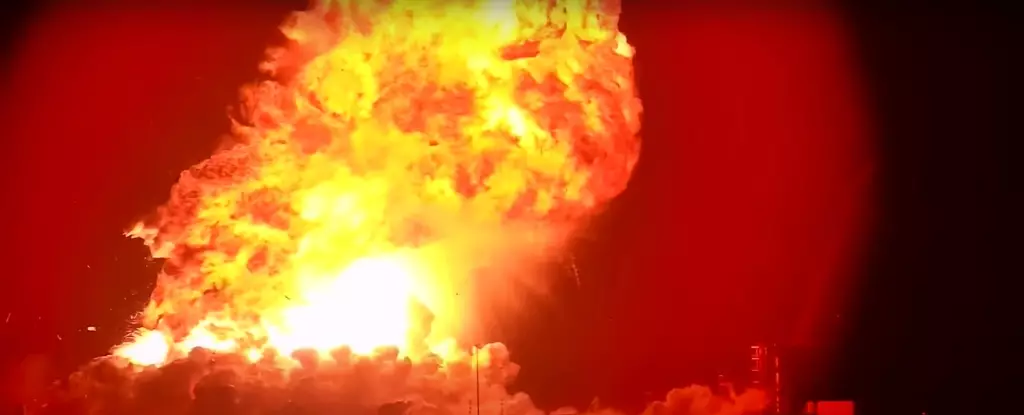On a fateful Wednesday night, SpaceX’s ambitions were starkly illuminated by an accidental explosion during what was supposed to be a routine static fire test in Texas. This catastrophic event served as a painful reminder of the precariousness inherent in the pursuit of interplanetary travel. While Elon Musk’s vision of colonizing Mars continues to dazzle investors and dreamers alike, the stark reality of the situation cannot be overlooked. Rockets are not merely mechanical devices; they are intricate and delicate systems where a single malfunction can lead to fiery disaster.
The news reports described a glaring fireball erupting at SpaceX’s Starbase launch facility, responding to a sudden “energetic event” which resulted in the outright destruction of the Starship rocket. Fortunately, the safety protocols were employed, ensuring the safety of personnel on-site. However, what this explosion signifies is a widespread engineering failure and an unsettling trend of repeated setbacks.
A Pattern of Failures
This incident is not an isolated tragedy for SpaceX but rather the continuation of a troubling pattern. The company has faced multiple disastrous outcomes with its Starship prototypes, including a catastrophic explosion over the Indian Ocean just months prior. With each failure, while Musk’s cool demeanor and casual dismissal—calling one incident “just a scratch”—reveal his resilience, they also highlight an uncomfortable truth: these lofty ambitions are built on a foundation that is far from stable.
The sequential nature of these failures raises the question: is SpaceX truly ready for the challenges of interstellar travel, or are we witnessing a relentless cycle of optimism overshadowed by dramatic setbacks? Musk often champions a “fail fast, learn fast” philosophy, yet one may wonder if this approach is encouraging a dangerous level of risk-taking without sufficient accountability. The very idea that these ambitious projects could evolve—aggressively—through such chaos is both inspiring and reckless.
Reliance on Space Innovation
While enthusiasts cheer for SpaceX—pointing to the substantial advancements they have made in commercial space travel, the repeated explosions bring a sense of urgency. The narrative often painted by proponents suggests that these failures are stepping stones to greatness. However, as the Federal Aviation Administration has greenlit an increase in launch frequencies from five to twenty-five annually, the concerns of environmental protection and safety standards should not be sidelined.
In a conflicting landscape where aspiration meets regulatory scrutiny, the so-called informed risks may actually lead to unintended ecological consequences. Conservation groups have voiced their objections against the expansion, fearing potential harm to vulnerable wildlife. When does enthusiasm for exploration become reckless disregard for Earth’s fragile ecosystems, a price that, if deemed necessary for progress, begs ethical questions about our priorities?
Contradictory Promises of Progress
SpaceX’s promise of a fully reusable rocket, equipped to handle vast payloads, sounds extraordinary on paper. Yet the reality of repeated failures dampens the celebratory tone surrounding these innovations. Each explosion serves to remind us that technology, no matter how grand its aspirations, is fallible. Musk’s insistence on rapid testing and innovation is admirable yet harrowing. With the ambition of creating human settlements on Mars hinging on successful launches, every setback endangers public trust and investor confidence.
Public and governmental faith in Musk’s vision has been largely unwavering, particularly with NASA becoming increasingly reliant on SpaceX for missions to the International Space Station. Yet, this reliance surely calls for stricter scrutiny—the successes must be weighed against the considerable price of these ongoing failures. Holding SpaceX accountable means ensuring they uphold the same standards expected of government-funded programs, which may not always align with a laissez-faire feel to private space exploration.
Thus, as we stand at the dawn of a new space age fueled by audacious dreams, the ambition to become an interplanetary species must partake in a more sobering evaluation of engineering failures. The “disposable” approach to rocket testing cannot take precedence over safety and ethical responsibility. In a world where exploration and environmental conservation clash, the path forward will demand a delicate balance that keeps both these monumental pursuits in mind.


Leave a Reply